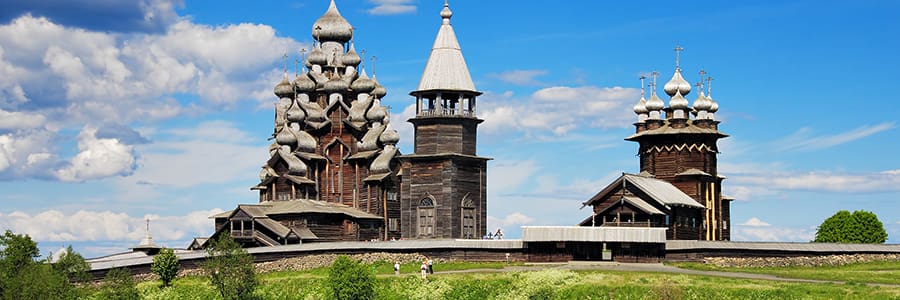
About The Svir River
How big is Russia? Fifty rivers enter Lake Onega, which covers an area of 3,753 square miles and itself empties into the Svir River.
Flowing out of Lake Onega, in the northeast of Leningrad Oblast, Russia, the Svir River flows westward for 139 miles into Lake Ladoga, thus connecting the two largest lakes in Europe. In the 18th century, Peter the Great connected the Svir with the Neva River via the Ladoga Canal, making it part of the Volga-Baltic Waterway.
For many outsiders, Russia remains a “riddle wrapped in a mystery inside an enigma,” but to travel through the country on a river cruiser is to gain a rare and intimate perspective on this exotic land and its people. From the breathtaking wooden churches on Lake Onega’s Kizhi Island, to the fairy-tale charms of Mandrogy’s open air museum, to St. Petersburg, the golden “Venice of the North,” the Svir carries you through centuries of Russian culture, religious heritage, and natural beauty, to give you a unique sense of how life in Russia really is.
Compared with other river cruise routes, Russia has a short season from early May through the end of October, with the high season being the June White Nights, with near-endless daylight, July, and August. Many of the major river cruise lines offer Russian itineraries; however, only Viking features its own ships. The Svir is almost always combined with the Volga and lakes of the region that form the waterways that connect Moscow and St. Petersburg.
Svir River Stats
Length: 139 miles
Depth: Up to 15 feet
Source: Lake Onega, Russia
Mouth: Lake Ladoga, Russia
Locks: 3
Countries: Russia
Learn More About the Svir River of Europe
The Svir River, flowing through northwestern Russia, is a watercourse that holds within its meandering path a rich tapestry of history, culture, and ecology. With a length of approximately 224 kilometers (139 miles), it originates from Lake Onega and drains into Lake Ladoga, two of the largest freshwater lakes in Europe. This river has played a pivotal role in the development of the Russian North, and its significance spans various domains, including transportation, industry, and ecology.
Geography and Hydrology
The Svir River is situated in the Leningrad Oblast of Russia and forms a natural border between the Republic of Karelia and Leningrad Oblast. It is nestled in a region characterized by dense forests, pristine lakes, and abundant wetlands. The river’s waters are remarkably clear, reflecting the unspoiled nature of its surroundings. Fed by numerous tributaries and springs, it provides a lifeline to the flora and fauna that depend on its waters. The Svir River is a part of the extensive Neva River basin, which ultimately flows into the Gulf of Finland. Its slow and meandering course through picturesque landscapes, featuring gentle bends and lush greenery, makes it a haven for nature enthusiasts and photographers. It’s not only a vital natural resource but also a place of unparalleled beauty and tranquility.
Historical Significance
The history of the Svir River is deeply intertwined with the development of the Russian North. The region surrounding the river has been inhabited for centuries by various indigenous peoples, including the Karelians and Veps. These cultures have left their mark on the landscape, with traditional wooden architecture and cultural practices still visible today. One of the most notable historical landmarks along the Svir River is the Kirillo-Belozersky Monastery, founded in the 14th century. This medieval monastic complex stands as a testament to the resilience and spirituality of the people who settled in this remote region. Over the centuries, it played a significant role in the spread of Christianity and the cultural development of the Russian North. The Svir River also played a pivotal role in the transportation of goods and people in the past. Before the advent of modern roads and railways, rivers were the primary means of communication and trade. The Svir, with its connections to Lake Onega and Lake Ladoga, facilitated the exchange of goods and the movement of people between these important water bodies. This transportation network was vital for the economic development of the region.
Ecological Diversity
The Svir River and its surrounding ecosystem are a testament to the importance of preserving natural habitats. The river and its tributaries are home to a diverse range of aquatic life, including various species of fish, such as salmon, trout, and pike. These fish play a crucial role in the food web and are valued both for their ecological significance and as a resource for local communities. The wetlands and forests along the Svir River also provide vital habitat for numerous bird species, including cranes, swans, and eagles. During the spring and autumn migrations, these wetlands become a stopover point for thousands of birds, making it a birdwatcher’s paradise. Conservation efforts in the region have focused on preserving the unique flora and fauna of the Svir River basin. Efforts to mitigate pollution, protect spawning grounds, and manage human activities near the river have been instrumental in safeguarding this vital ecosystem.
Modern Uses and Challenges
In the present day, the Svir River continues to play a role in the transportation of goods, albeit to a lesser extent than in the past. The development of modern infrastructure has shifted the emphasis to road and rail transport, but the river remains an important asset for local communities and businesses. However, the Svir River, like many water bodies around the world, faces environmental challenges. Pollution from industrial and agricultural sources, as well as the effects of climate change, pose threats to its water quality and the health of its ecosystem. Sustainable management practices and conservation efforts are essential to ensure the river’s long-term health and vitality.
